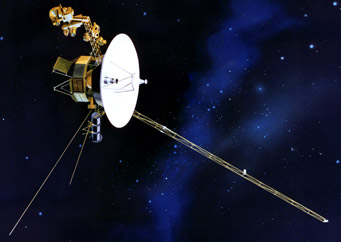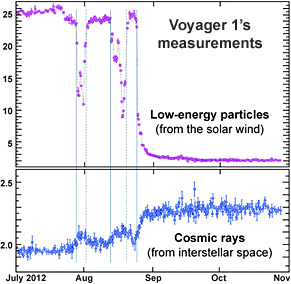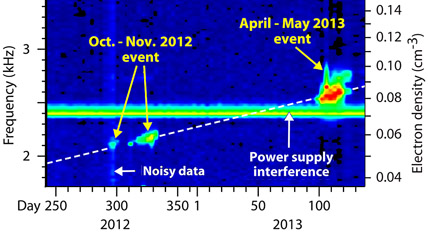After a year of conflicting assessments, scientists for NASA's Voyager 1 spacecraft believe the probe crossed into interstellar space in August 2012.

Roughly 12 billion miles from home, the Voyager 1 spacecraft is still collecting data. Engineers predict it should have enough power to function through 2020 and perhaps until 2025.
NASA / JPL-Caltech
A key milestone, 36 years in the making, was announced yesterday. The Voyager 1 spacecraft, having traveled outward 12 billion miles from the Sun (more than three times Pluto's mean distance) since its launch in 1977, has signaled its arrival in interstellar space. NASA associate administrator John Grunsfeld called it "a first in the history of exploration."
It has long been speculated that Voyager 1 would eventually cross the heliopause, the outer limit of the Sun's solar-wind bubble, but predicting exactly when has not been easy. It started picking up radio static from the turbulent boundary with the interstellar medium decades ago, and in 2004 it noted that the solar wind had decelerated to subsonic speed.

Midway through 2012, Voyager 1's instruments noted a precipitous drop in the number of solar-wind particles recorded per second — and simultaneously noted a surge in cosmic rays arriving from interstellar space.
NASA / JPL / GSFC
Then, in August 2012, the craft relayed that cosmic-ray counts had jumped — exactly the effect that space physicists expected to find in interstellar space. But, curiously, there was no corresponding change in the direction and intensity of the magnetic field. So for months researchers convinced themselves that the spacecraft had merely reached a kind of on-ramp to the heliopause.
Although the Voyager team continued to insist that the craft was not yet in interstellar space, others were more convinced. And the expected change in the magnetic field proved to be "something of a red herring," says Marc Swisdak (University of Maryland). In the September 1, 2013, issue of Astrophysical Journal Letters, he and two coauthors offer detailed modeling of the magnetic interactions along the heliopause. They conclude that the magnetic fields at the edge of the heliosphere and local interstellar medium must intersect at a very small angle.
Interestingly, Swisdak's magnetic-field simulations suggest that Voyager 1 crossed the heliopause very close to July 25, 2012, when the last reversal of the field's direction occurred. That's a month earlier than the cosmic-ray flux spiked and the solar-wind counts plummeted. The later events, he says, result from a mixing of the solar-wind and interstellar plasmas in
Now the Voyager team agrees that the changes seen in August 2012 truly did herald the long-awaited crossing. The evidence is compelling, if circumstantial.
In yesterday's online edition of Science, a quartet of mission scientists led by Donald Gurnett (University of Iowa) report that the craft has recorded pronounced changes in the plasma waves in its vicinity. These waves are sensitive indicators of how much plasma is present. In fact, Gurnett notes, the electron density scales as the square of the frequency. So if the frequency goes up, then the charged-particle density must be increasing as well.

This plot shows how the frequency of plasma waves in Voyager 1's vicinity — and therefore the density of electrons within the plasma — has increased over the past year. The higher values match the plasma density expected for the interstellar medium outside the heliosphere.
NASA / JPL / Univ. of Iowa / Science
Fortunately, two strong solar-wind blasts from the Sun, which reached the spacecraft in October-November of last year and then again in April-May 2013, triggered a pulse of detectable plasma waves. (The spacecraft was also equipped with an instrument to measure the plasma concentration and composition directly, but it failed in 1980.)
Since the interstellar medium's plasma is denser that the tenuous solar-wind plasma at Voyager 1's distance, the increase recorded over the past year is a clear sign that the spacecraft has exited the heliosphere. "The plasma density turned out to be about 100,000 electrons per cubic meter — "almost exactly what we expected in the interstellar plasma," Gurnett notes.
"It's a very exciting time for me," admits Gurnett, who is one of several investigators who have tended to the spacecraft's scientific instruments from the outset.
"We made it — while we still had enough power," says a relieved Edward Stone, the Caltech physicist who has served as mission's project scientist from the outset. Engineers estimate that Voyager 1's plutonium-fueled power system can provide adequate electricity for current operations only until about 2020. After that they'll have to switch off its instruments one by one.

The first hints that Voyager 1 was nearing the edge of the heliosphere came in 2004. Since then space physicists have been challenged to identify exactly when and where the spacecraft crossed into interstellar space.
Randall Munroe / xkcd.com
In deference to some who've posted comments about this article, Voyager 1 has not yet left the Sun's realm entirely. For example, it has yet to traverse the Oort Cloud, a reservoir of trillions of comets that extends outward to perhaps 50,000 a.u.
Nor will the Sun lose its gravitational grip until the spacecraft is at least a few light-years away. (It's headed in the general direction of Gliese 445, an M-type star in Camelopardalis that's 17.6 light-years from us.)
Nonetheless, Voyager 1 is finally living up to its billing as an interstellar mission. Voyager 2, also headed toward the stars, is currently 9.5 billion miles (102 a.u.) from the Sun.
Read more details in NASA's press release.
 21
21
Comments
Anthony Barreiro
September 13, 2013 at 3:40 pm
This is a wonderful event! Today is a great day to be a human being. It's truly awe-inspiring that the Voyager probes have continued to work for 36 years, and that we are still able to receive their data transmissions. Onward toward the stars, little space probe!
You must be logged in to post a comment.
Jerry
September 13, 2013 at 4:05 pm
Great news, but I'm confused. First paragraph says 12B miles from the Sun for Voyager 1; but in last paragraph Voyager 2 is 95B miles from sun, and still in heliosphere. The heliosphere is not spherical of course, but the difference between 12 and 95 billion miles has to be a mistake in one number or the other, no?
You must be logged in to post a comment.
Jerry
September 13, 2013 at 4:16 pm
Both numbers are associated with a.u.'s (about 120, and 102), and using those numbers, it looks like the 95 billion miles is correct, but the 12 billion should be 112 billion.
You must be logged in to post a comment.
Stan Kerns
September 13, 2013 at 4:31 pm
I think we all know perfectly well that the Oort Cloud extends about a light year from the Sun, and is part of the Solar System.
Stan
You must be logged in to post a comment.
Daniel A. Allison
September 13, 2013 at 5:31 pm
Since the Ort Cloud is in orbit around the sun isn't it part of the solar system? Voyager will not leave the Ort Cloud for another 100,000 years or so, if it survives all the comets there. The title seems to be misleading, at best. I doubt that any of us will be alive when and if it leaves the solar system.
You must be logged in to post a comment.
charles
September 13, 2013 at 7:19 pm
I think it is supposed to be voyger 2 is 9.5 billion miles from the sun.
You must be logged in to post a comment.
Mike Martin
September 13, 2013 at 8:27 pm
If you read the NASA Press Release it states Voyager 1 is 12billion miles out and Voyager 2 is 9.5 billion miles out. Just a typo, but non the less an Historic Day for Space Exploration . Voyager 1 and 2 " Will go where no Man has gone Before " Sorry I had to, Mike
You must be logged in to post a comment.
bennett
September 13, 2013 at 8:46 pm
adastra Voyager.
http://www.heavens-above.com/SolarEscape.aspx?Session=kebgfbelhkiaobiemggbplah
try this link
You must be logged in to post a comment.
JohnM
September 13, 2013 at 9:50 pm
In the midst of all the happy news about Voyagers 1 and 2, let's not forget that Pioneer 10 was in fact the first man-made object to depart the Solar System, and it is still going. . .a true pioneer that showed the way for Voyager.
You must be logged in to post a comment.
Dimitri
September 14, 2013 at 11:18 am
NASA has made a terrible mistake!! Voyager 1 didn't enter interstellar space!! The final frontier is 200,000AU or 3.2 Light Years!!!.... This the last limit of our solar system. I wonder who knows Astronomy.......
You must be logged in to post a comment.
Frank Reed
September 14, 2013 at 12:31 pm
I agree with some of the comments above that the headline that the NASA p.r. folks have chosen for this story is a little misleading --though the press release and most coverage, including this article, are very clear on the distinction. The spacecraft has left the heliosphere. The plasma environment it is now travelling through is outside the Sun's influence and therefore qualifies as "interstellar", but there are many ways to define the size of the Solar System. Even the orbit of Neptune, the outermost major planet, would make a good departure point... But let's remember, the distance Voyager 1 has traveled is still NOTHING compared to the distance to the nearest star. At present Voyager 1 is about 125 AUs from the Sun, which is four times the distance of Neptune. But (probable) dwarf planet Sedna has a mean distance from the Sun of more than 500 AUs so there's still a lot of massive "stuff" out there that belongs to the Solar System. It is very likely that there are dozens of dwarf planets and many thousands of minor planets at much greater distances (even ignoring the Oort Cloud). And the next nearest STAR?? That's about 268,000 AUs away, over 2000 times the distance that Voyager 1 has travelled since its launch in 1977..... It is genuinely amazing that this decades-old spacecraft continues to function and has now been declared solidly beyond the heliopause, but "in" or "out" of the Solar System is very much a matter of definition.
You must be logged in to post a comment.
Frank Reed
September 14, 2013 at 12:41 pm
Dimitri, NASA has not made a "terrible mistake". They've tried to explain a milestone in this mission --passing the heliopause-- in simple terms, and some of the media coverage (not here) has simplified further. This exit from the heliosphere qualifies as entry into "interstellar space". But the expression "leaving the Solar System" is probably misleading. There are still plenty of substantial bodies orbiting the Sun which are beyond the heliopause. The Solar System does not end at the heliopause. As for your suggestion that the "final frontier" is at 200,000 AUs, uh, may I ask, where did you get that idea??
You must be logged in to post a comment.
Kelly Beatty
September 14, 2013 at 3:00 pm
if you read the story carefully, you'll see that I never said Voyager 1 had left the solar system, but rather that it had left the heliosphere and entered interstellar space.
You must be logged in to post a comment.
Peter W
September 14, 2013 at 5:03 pm
Interstellar space can also be defined as the distance at which the sun is no longer the brightest star.
You must be logged in to post a comment.
Frank Reed
September 14, 2013 at 5:12 pm
Kelly Beatty, you wrote:
"if you read the story carefully, you'll see that I never said Voyager 1 had left the solar system, but rather that it had left the heliosphere and entered interstellar space." Quite so, and your wording is careful. And I should emphasize very clearly that the reporting from S&T.com, and of course you personally, continues to be of the highest caliber (while other online popular astronomy sources sink into mediocrity). But you'll notice even here, with your very high standards, that the sidebar cartoon poking a little fun at the number of times that Voyager 1 has been declared to have left the heliosphere reads "Number of times Voyager 1 has left THE SOLAR SYSTEM". It's actually hard to see it on first pass, that change in language comes so easily.... We've all been waiting for this for many, many years. I have vivid memories from my summer after 8th grade, studying every detail from the issue of S&T anticipating the launch of the Voyager spacecraft. But in all those years, it seems we never really considered the terminology. Leaving the heliopause places Voyager 1 in the interstellar medium, but calling it interstellar "space" now seems problematic since it is well within the orbits of Solar System objects (like Sedna at its mean distance) which were quite unknown when this whole discussion started in the late 1970s. The terminology needs a little help...
You must be logged in to post a comment.
Mike Martin
September 14, 2013 at 6:37 pm
There seems to be quite a bit of controversy on where the Solar System ends. We have a lot of knowledgable people who read this Blog. Can we get a good consensus of opinion on this matter. I've researched this subject and found maybe a dozen different theories. Can we come to a common conclusion. Clear Skies. Mike
You must be logged in to post a comment.
Bruce
September 14, 2013 at 6:55 pm
Nice comments Frank.
Mike, right after we can all agree on how to define "planet", then we can tackle your suggestion, perhaps?
You must be logged in to post a comment.
T West
September 15, 2013 at 11:47 am
Article full of errors. Must have been written by a child.
You must be logged in to post a comment.
Michal
September 15, 2013 at 6:46 pm
Sorry Pioneer 10, but the NASA information page states the following:
"On February 17, 1998, Voyager 1 passed the Pioneer 10 spacecraft to become the most distant human-made object in space." Pioneer 10 was the first spacecraft to attain escape velocity from the solar system, however Voyager 1 has a greater speed than the Pioneer and Voyager 2 spacecraft. All are just incredible missions for 40-50 yr old tech.
You must be logged in to post a comment.
DVeT
September 16, 2013 at 11:38 pm
I've always had problems with a defined edge to the helio-pause. Voyager-1 isn't even past the Ort-cloud, and is in really bad shape! And we're suppose to accept this failing machine's data as instructive? I think not!
Once we get 100's of robot satellites going out to the Pascal Limit, we just might be able to understand our location in the Milky Way Galaxy!
Until then it's all a mathematical fancy!
You must be logged in to post a comment.
V Rose
September 22, 2013 at 8:29 pm
Where is pioneer 10 headed? and where is voyager 2 headed ?
You must be logged in to post a comment.
You must be logged in to post a comment.